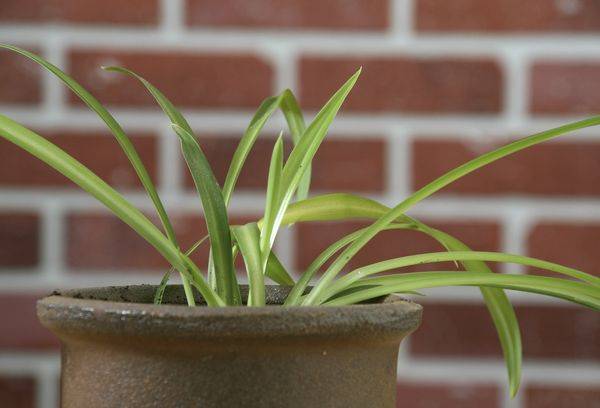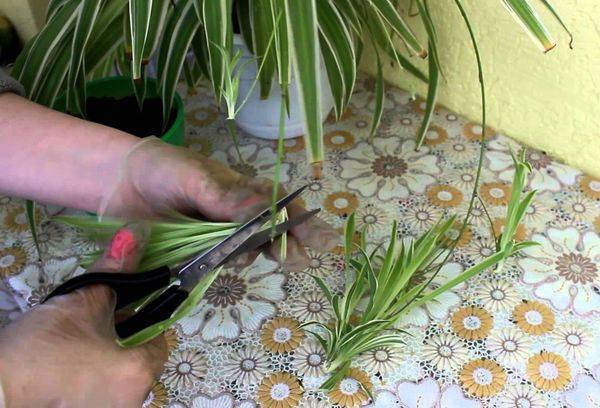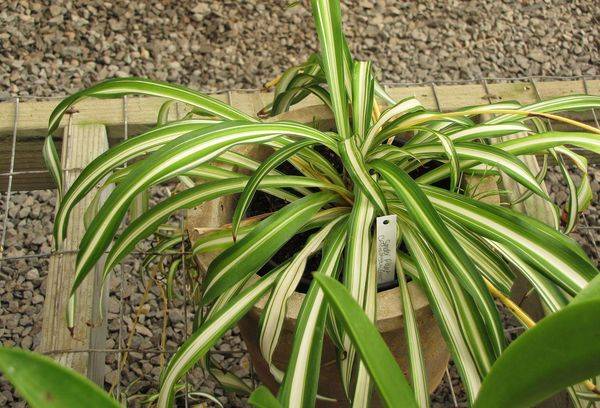Growing at home Chlorophytum crested
This plant is a frequent resident on window sills in apartments. Chlorophytum crested is easy to recognize: it has characteristic narrow elongated green leaves with white stripes, forming a lush bush. The popularity of the flower is explained by its unpretentiousness, beauty and benefits. Chlorophytum clears the room of carbon dioxide, so it is grown not only in apartments, but also in offices, hospitals and kindergartens.
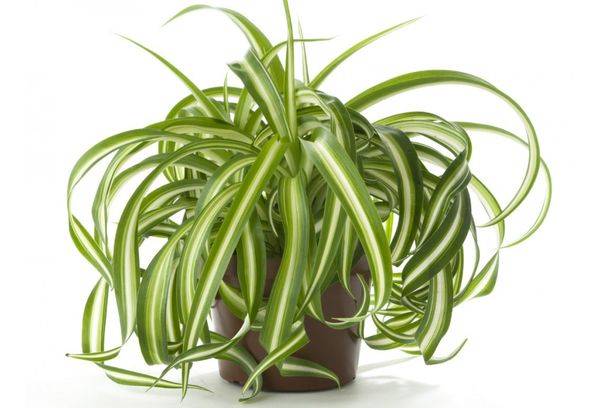
Chlorophytum crested Mandainum
Description
Chlorophytum crested (Latin name - Chlorophytum comosum) - a guest from South Africa, is a lush rosette of long leaves, which are its main decorative value. The flower has practically no stem, and therefore it is grown mainly as a hanging flower. However, the beauty of chlorophytum will appear not only in hanging flower pots - it will also be irresistible in an ordinary flowerpot on the windowsill.
Depending on the variety, the plant can stretch up to 60 cm in height. The most famous species has light green leaves with white stripes, but indoor chlorophytums with orange and yellow stripes are also found. Another feature for which chlorophytum is loved by gardeners is the daughter rosettes of leaves growing at the ends of long tendrils.
The flowers of Chlorophytum crested resemble small lilies, the buds are collected in inflorescences of 3-7 pieces. At home, the plant rarely blooms, unlike in greenhouses and in the wild.
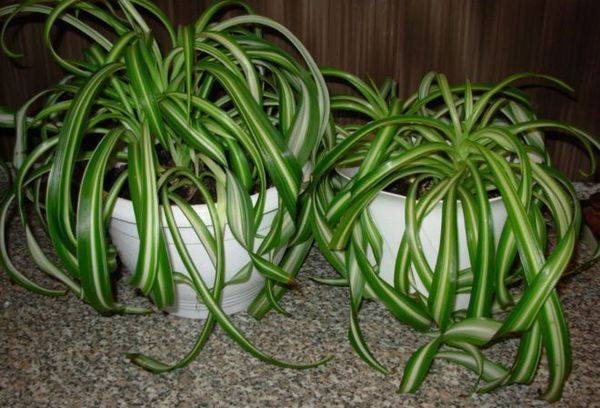
Chlorophytum crested (Bonnie)
Chlorophytum crested has several interesting varieties:
- Variegatum - one of the most popular. It is characterized by the presence of white stripes along the edges of the leaves.
- Vittatum - this chlorophytum has a white central part of the leaf and green edges.
- Maculatum - the owner of leaves with longitudinal yellow lines.
- Bonny - a compact plant with curved leaf blades, along the center of which there is a white stripe.
- Mandainum - This variety of crested chlorophytum has one wide yellow line in the center of the leaf.
Care: basic rules
Chlorophytum crested feels great in almost any conditions. However, this does not mean that watering it once a month is enough; some rules still exist. The main principle of care is moderation. This applies to lighting, watering, soil and fertilizers.
As for placement in the house, it is better to place Chlorophytum crested in places with diffused light. Each variety has its own preferences for the amount of sun. Thus, variegated varieties require more of it; with a lack of lighting, the patterns quickly fade and cultivated varieties become similar to the wild green species.
Advice
Do not expose flowerpots to direct sunlight: the result will be red leaves, evidence of sunburn.
The temperature in the room where chlorophytum lives should be standard room temperature - from +18 to +22 degrees. The plant does not like heat above +30, but it will withstand a short-term drop in temperature to +10.
Designer recommendations:
- place the vase with chlorophytum on a high stand;
- it is better to place a pot with a tall variety on the floor;
- a lush bush looks beautiful in hanging flowerpots on the wall;
- A good option is to simply place the flowerpot on the windowsill, but do not forget about light shading.
Watering, humidity and fertilizers
Normal watering of chlorophytum is 2-3 times a week in summer, in winter - no more than 2-3 times a month (in cool rooms). The soil in the flowerpot should always be moderately moist: you should not allow the soil to dry out, but you also do not need to flood the plant. Each subsequent watering is carried out after the top layer of soil has dried. Water - warm, soft, preferably settled for about 2 days. The liquid that has drained into the pan must be removed so as not to provoke fungal disease and rot.
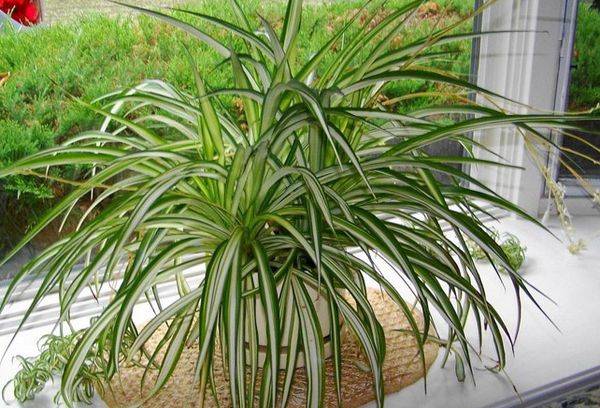
Maculatum
Chlorophytum reacts negatively to low air humidity. In dry rooms, it is recommended to periodically spray the plant and increase the amount of water for irrigation.
Advice
Recommendation from the magazine purity-en.htgetrid.com: in winter, it is better not to place Chlorophytum crested close to a working heating system. Due to insufficient air humidity, the tips of the leaves of the flower may dry out.
The plant will be grateful if you wipe the dusty leaves with a damp sponge. This must be done extremely carefully so as not to damage the fragile sheet plate. If you are afraid, then place the bush under a light shower, having first covered the soil.
Fertilizing is done in spring and summer during the period of active growth. In winter, the plant does not need fertilizers. Regular liquid mineral complexes will do. Fertilizer is applied 4-5 hours after the main watering. The frequency of feeding is once a week.
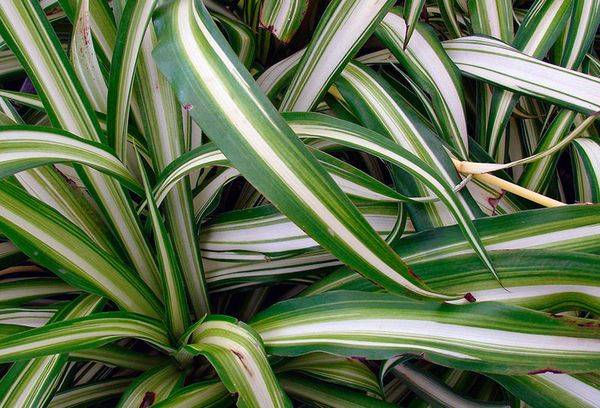
Chlorophytum Vittatum
Transplantation and propagation
The container for Chlorophytum crested is selected to be spacious so that the root system fits freely. The recommended distance from the roots to the walls is at least 1 cm. The soil is permeable, medium or light, without peat and clay. To prepare the soil yourself, you will need:
- leaf soil - 1 part;
- humus - 1 part;
- sand (coarse) - 1 part.
Plants are replanted annually in early spring. If you do not change the pot to a larger one, the flower will become cramped, roots will crawl out of the drainage holes, and growth will slow down. When moving to the bottom of the container, do not forget to lay out a drainage layer of expanded clay or small stones. Due to the fragility of the root system, the plant is replanted using the transshipment method, that is, without removing the clod of earth from the roots. After the procedure, be sure to water the plant with warm water.
Chlorophytum crested is propagated in the following ways:
- Seeds. The method is rarely used at home.
- Dividing the bush. The method is suitable for large plants. When transplanting, separate the parts on which the roots and growth points necessarily remain. The delenki are planted in different containers, covered with soil and watered.
- Tendrils with aerial rosettes grow from the axils of the leaf blades. When roots appear on them, they are cut off and planted in a separate flowerpot.
Growing problems
Chlorophytum crested is resistant to diseases, but occasionally suffers from root rot - when liquid stagnates in the soil. The leaves will tell you that the plant is flooded: they will turn yellow. Also, with excessive watering, gardeners often observe black spots on the leaf blades, and with insufficient watering, dry tips. Another reason for yellowness is excess sunlight.
Dry air and insufficient watering are favorable conditions for the proliferation of spider mites. The mealybug migrates from other plants to the chlorophytum, and another flower lover is the aphid. To get rid of parasites, wipe the leaves with soapy water or use special insecticides.
Interesting Facts
Chlorophytum crested is not just a decorative air freshener.Here is some more interesting information about the flower:
- It has been used for indoor landscaping for 200 years.
- Due to the shape of the flowers, the plant has another name - St. Bernard lily.
- The plant not only absorbs carbon dioxide, but also destroys pathogenic microorganisms.
- Growing Chlorophytum crested is an excellent solution for those who are subject to great mental stress. In rooms with this plant there is always healthy air, rich in oxygen.
Important
Chlorophytum is dangerous for cats. Its leaves contain hallucinogenic substances that attract pets, as well as chemical compounds that cause vomiting and diarrhea. Restrict cats' access to the planter by hanging it or placing it on a stand.
Its love of life and ease of care make chlorophytum one of the most popular indoor plants among novice gardeners. But professionals are also attracted to the decorative bush with striped leaves.
